Chapter 4. Project integration management: Getting the job done
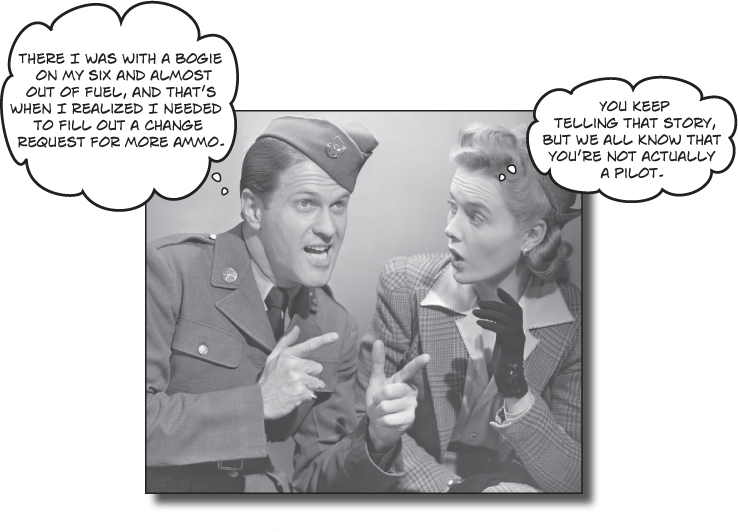
Want to make success look easy? It’s not as hard as you think. In this chapter, you’ll learn about a few processes you can use in your projects every day. Put these into place, and your sponsors and stakeholders will be happier than ever. Get ready for Integration Management.
Time to book a trip
Everyone in the Midwestern Teachers’ Association has gotten together and planned a trip—a tour of Asia and Europe, starting with Mumbai, India, and ending up in Paris, France.


Larry’s cutting corners
Larry wants to dive into the project and make his clients happy. When he sees an opportunity to save them money, he takes it! But sometimes the cheapest way to do things isn’t the way that will end up satisfying everyone.
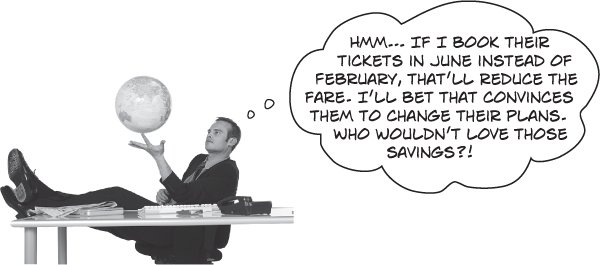
The teachers are thrilled…for now
Larry convinces the teachers to travel in June because of the great price he got on tickets. But he’s not really planning for the results of that decision—and neither are the teachers.
One of the keys of project management is thinking a project through before starting the work, so problems that could arise down the line are anticipated ahead of time. That’s why so much of project management is spent planning.
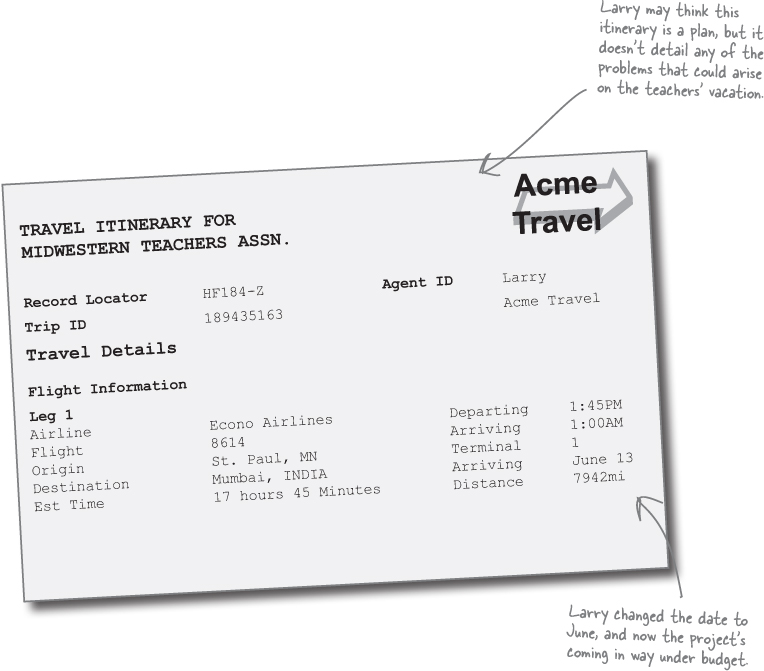
These clients are definitely not satisfied
When the clients arrived in Mumbai, they found out why the fare was so low: June is monsoon season in India! Larry may have saved them a bundle, but it didn’t keep him from soaking his clients.

Larry’s been let go
From the minute they got off the plane, the clients were extremely unhappy. The senior managers at Acme Travel don’t want to lose the teachers’ business…so they’ve appointed YOU as the new travel agent.
It’s your job to finish planning the trip, and make sure that the teachers leave their vacation satisfied.
The day-to-day work of a project manager
Project managers make projects run well. They plan for what’s going to happen on the project. A big part of the job is watching closely to make sure the plan is followed, and when things go wrong, making sure they’re fixed. And sometimes the plan itself turns out to be inadequate! Project managers look for those kinds of problems, and fix them too. That day-to-day work is what the Integration Management processes are all about.
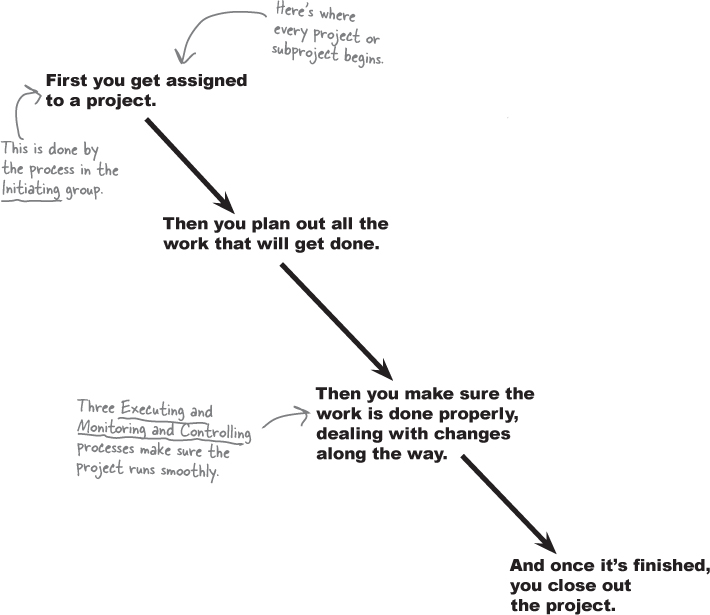
A bird’s-eye view of a project
Every project follows the same kind of pattern. First it gets initiated, then planned, then executed (and monitored), and finally closed. That’s why the process groups are so useful—they’re a good way to think about how you do the work.
For a large project, you’ll often see this pattern repeated several times. Each major chunk of deliverables is treated as its own subproject that goes through all of the process groups and processes on its own.
Note
So you always need to use the processes in the Closing group, even when it’s a subproject of a larger project.
The seven Integration Management processes
The PMBOK® Guide divides Integration Management into seven processes that you need to understand for the exam. They’re what people usually think of as a project manager’s “core” responsibilities.
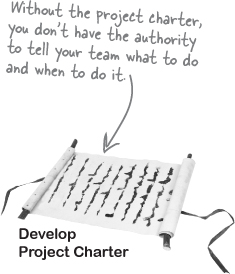
Develop Project Charter
The very first thing that’s done on a new project is the development of the project charter. That’s the document that authorizes you to do your work. But you’re not always involved in making it—oftentimes it’s handed to you by the sponsor.
Note
The sponsor is the person who pays for the project.
Develop Project Management Plan
The Project Management plan is the most important document in the entire PMBOK® Guide because it guides everything that happens on the project. It spans all of the knowledge areas.
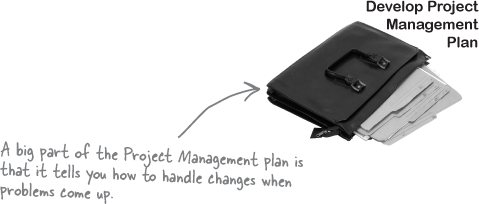
Direct and Manage Project Work
After you’re done planning, it’s time to do the work. Your job is to make sure that everybody is doing what they should be doing, and that the products or services your project creates meet the needs of the stakeholders.
Note
Here’s where the work gets done. It’s where all of the planning you’ll do in all of the other knowledge areas comes together so that you can actually make stuff. It’s the day-to-day work that you help your team do, and make sure gets done.
-
This process is all about building on the knowledge your team already has about the project and using it to solve problems as they come up. Sometimes your team will discover new information that the organization never had before. When you’re managing your project’s knowledge, you’re helping to make sure that those new discoveries are understood throughout your organization.
Note
It might seem like this one is focused on documentation, but sharing information doesn’t always happen through documents.
Monitor and Control Project Work
A good project manager is constantly monitoring every single thing that goes on in the project. Remember, the later you find a problem, the harder and more expensive it usually is to fix.
Note
Keep everyone satisfied by catching problems as early as possible.
Perform Integrated Change Control
Note
Once you catch problems, this is where you figure out how to fix them—or if they should be fixed at all.
Once you’ve found problems on your project, you’ve got to work with your stakeholders and sponsors to figure out how to deal with those problems. You should also update your Project Management plan to reflect any extra steps you’ll need to take to complete the project. Updating the Project Management plan also makes sure everyone working on the project stays on the same page.
Note
Keep an eye out for potential changes. Part of your job is helping the people around you anticipate changes, and maybe even prevent them.
Close Project or Phase
The last thing you do on the project is close it out. Make sure you document everything…especially the lessons you and your team have learned along the way. You can never tell when these lessons may help you out on your next project.
Start your project with the Initiating processes
These are only two processes in the Initiating process group, and they’re all you need to get your project started. First, the Develop Project Charter process tells everyone in the company why the project is needed, and gives you the authority you need to make it happen. Then you use the Identify Stakeholders process to figure out who is affected by the project and how to communicate with them.
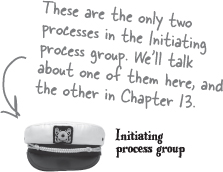
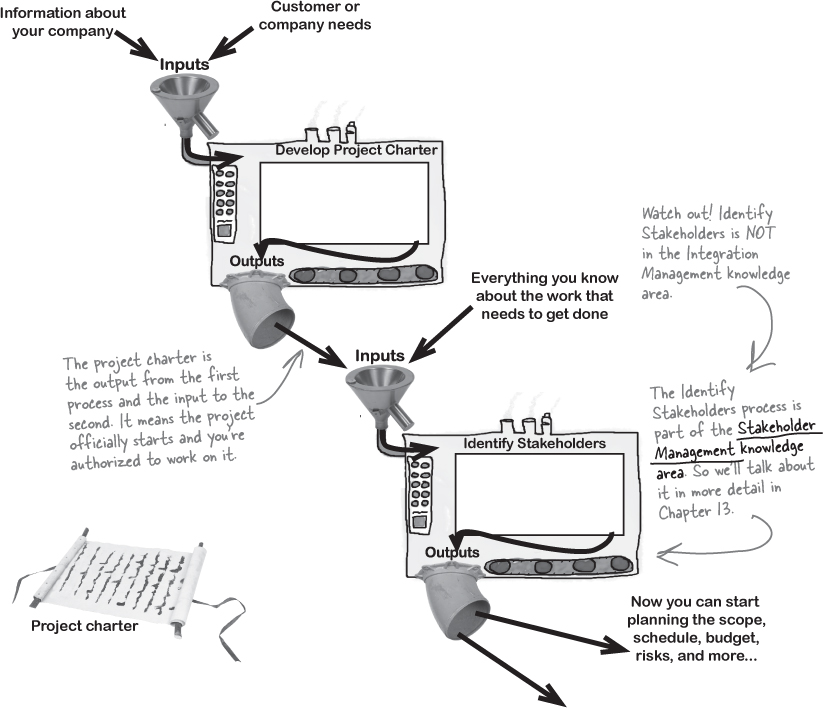
Integration Management and the process groups
Here is how the process groups all fit into this whole Integration Management thing. The process groups show you the order in which these processes happen, and how they interact.
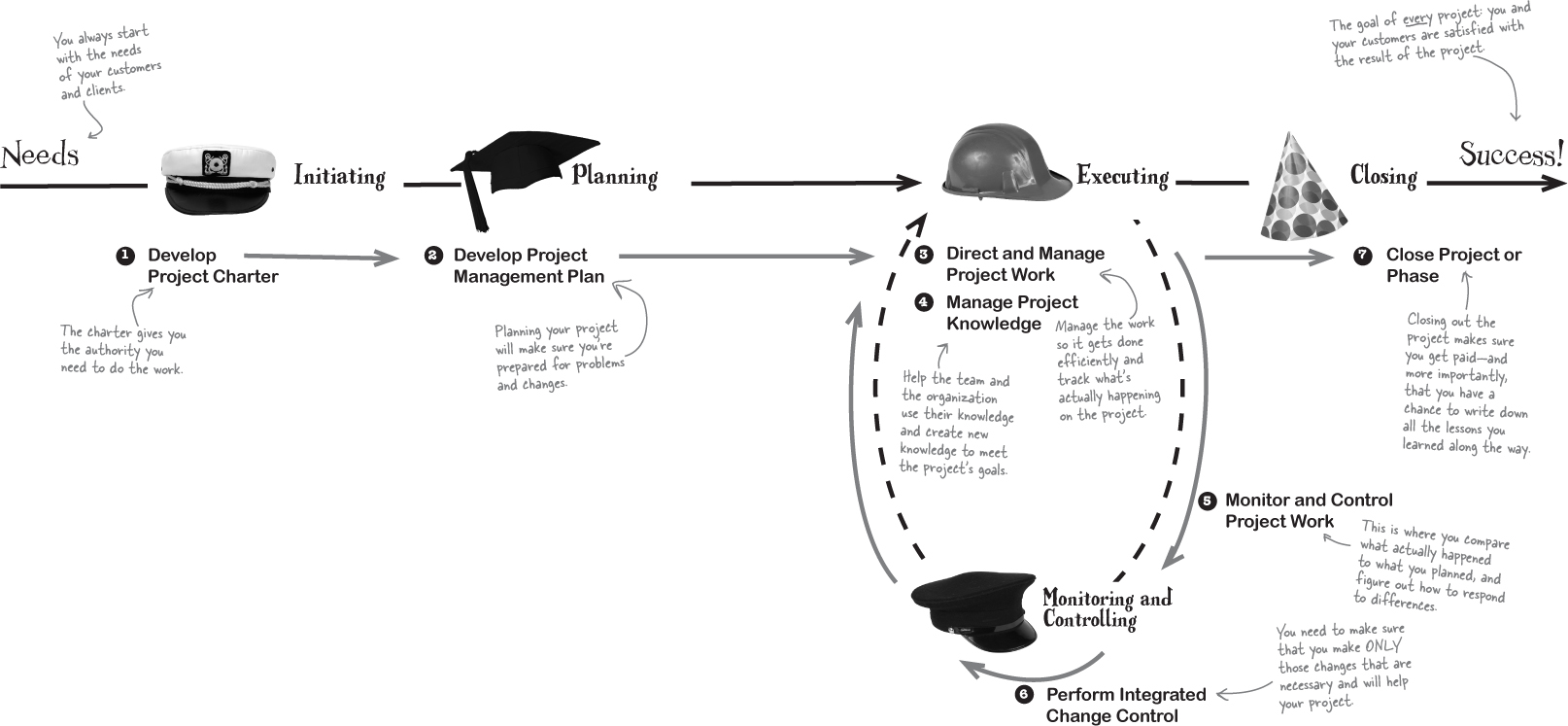
The Integration Management knowledge area brings all of the process groups together. A project manager has to integrate the work of everyone on the team through all of these major activities to keep the project on track:
Being authorized by the project charter to control the budget and assign resources
Planning all of the work that’s going to happen throughout the project
Directing the work once it gets started
Using the information your company already knows about this project and keeping track of all of the new things you learn
Monitoring the way the work progresses and looking for potential problems
Looking out for changes, understanding their impacts, and making sure they don’t derail the project
Closing out the project and making sure that there are no loose ends when it’s over
The Develop Project Charter process
If you work in a matrix organization, then your team doesn’t report to you. They report to functional managers, and might have other work to do. But when they’re on your project, you’re effectively their boss. So how do you make that happen? Well, you need some sort of authorization, and that’s what the project charter is for. It says exactly what you’re authorized to do on the project (like assign work to the team members and use the company’s resources), and why you’ve been assigned to it. But the charter isn’t just important for matrix companies. In any kind of company, it’s really important to know who’s in charge, and what resources you have available to you when you manage a project.

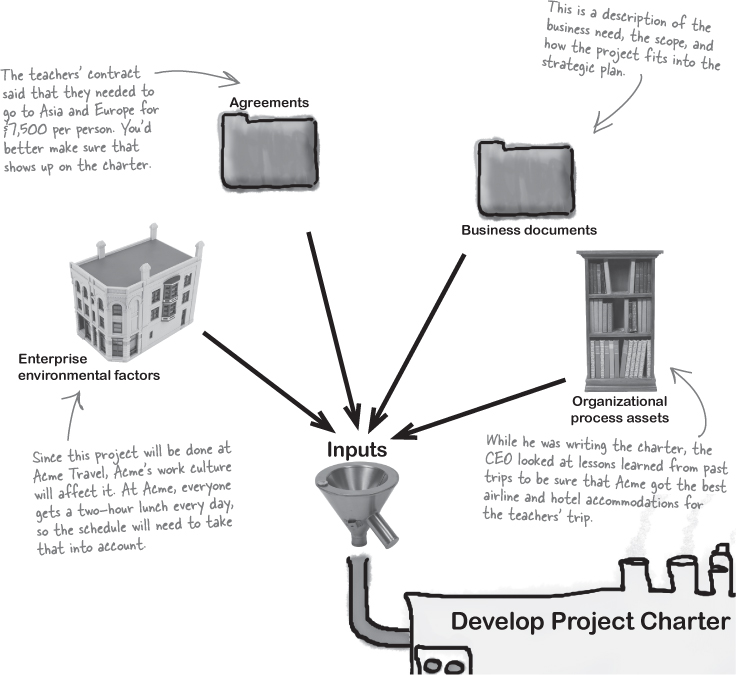
Make the case for your project
The Midwestern Teachers’ Association contract wasn’t the only one that Acme could have taken. The company’s got more work than it can handle right now, and occasionally it needs to turn away a client. That’s where a business case and benefits management plan come in handy. If a project is too risky, won’t make enough money, isn’t strategic, or isn’t likely to succeed, then the senior managers at Acme could choose to pass on it.
But to figure all that out, you need to do some thinking about what makes taking on this project a good idea for Acme Travel. Preparing business documents means thinking about the value of the project to the business. Is there a big market for world travel packages that Acme can break into if it does this project? Should Acme do it just because the customer requested it? Will it help the company in other ways?
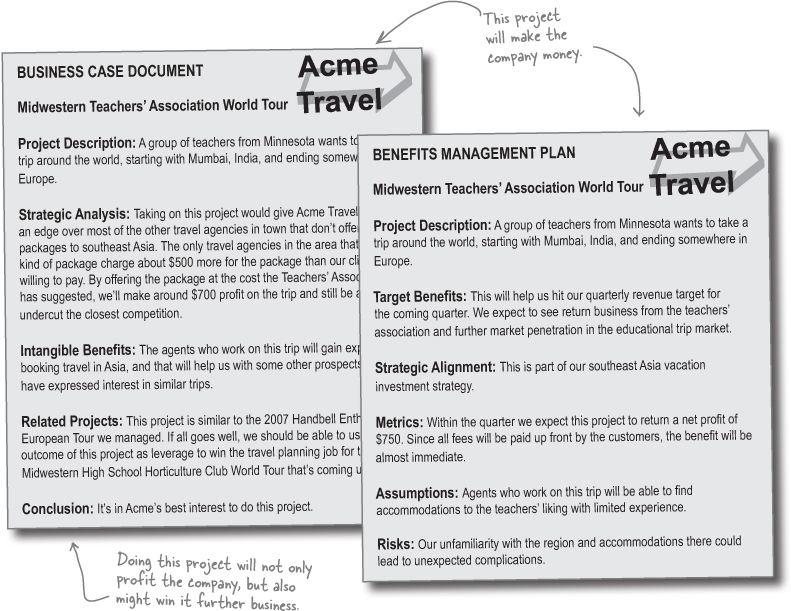
Use expert judgment and data gathering techniques to write your project charter

When you think about it, a lot of different people’s opinions can help your company come to a good decision about whether or not to start a project. Sometimes project sponsors will call on experts to help them decide which projects to do. At Acme Travel, the CEO called a meeting with the VP of Asia Travel to make sure that the teachers’ trip was worth doing. The VP of Asia Travel had set up trips like this one before and knew where things could go wrong in planning them. Together, they looked at all of the project documentation to make sure that this project looked like it would make Acme enough money to be worth doing.

Your company might need to talk to subject matter experts from a bunch of different departments to decide if a project will be beneficial to it. It might rely on outside consultants or industry groups to tell it how other companies have solved the same problem. All of those different opinions are called expert judgment.
If the experts agree that the project’s business case and contract add up to a product that’s going to do good things for your company, they’ll usually give the green light to write the charter.
Data gathering techniques help everyone understand the goal of your project
When you sit down to write your project charter, you’ll need to get your stakeholders on the same page about what your project team will do. You might set up meetings with your stakeholders to brainstorm project goals or work with them to resolve conflicts around how your project will run. All of the approaches you take to get everybody on the same page are called data gathering techniques. Unlike expert judgment, which relies on people using their past experiences to make decisions, data gathering techniques involve meetings and sessions that use hard data to reach an agreement on major project decisions.

Interpersonal and team skills and meetings make sure everyone is on the same page
When a project is just beginning you need to think about many different perspectives. The best way to get a clear picture of how your project fits into the organization’s strategic goals is to get everyone together and talk about it. You’ll need to use interpersonal and team skills like conflict management facilitation and meeting management to help make those conversations successful. You’ll also need to rely on your meeting management skills to make sure that the decisions that are made in the meetings are clear to everyone.

A closer look at the project charter
The charter is the most important output of the Develop Project Charter process. We know that it makes sense to do the project—that’s what we did with the business case. And we know that it assigns authority so that you can do your job. But what else does a charter have in it?
The only other output is the assumption log. During the course of building the project charter, you should keep track of the assumptions you’re making as you define the project. Those assumptions will help the project team understand what was considered when the project was approved.
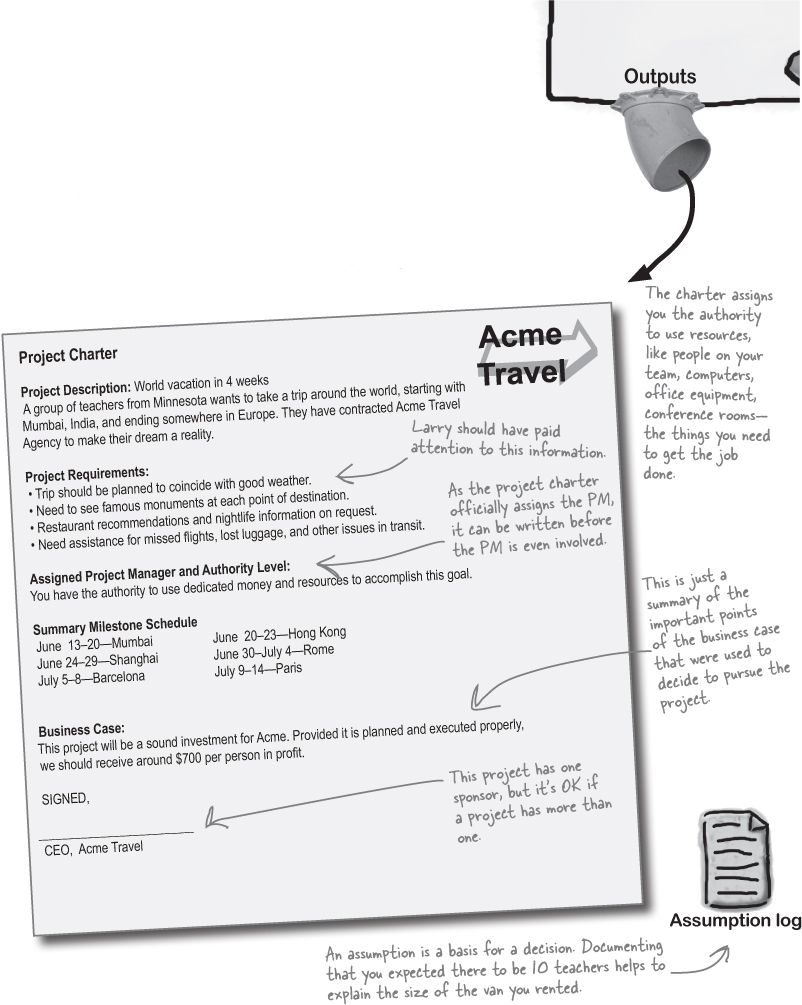
Two things you’ll see over and over and over…
There are two inputs that you’ll see repeatedly for a bunch of different processes throughout the rest of the book. Enterprise environmental factors are anything that you need to know about how your company does business. And organizational process assets have information about your projects: how people in your company are supposed to perform them, and how past projects have gone.
Enterprise environmental factors tell you about how your company does business.
There’s a lot of information about your company that will be really useful to you when you’re planning your project. You need to know how each of the different departments operates, the market conditions you’re working in, the company’s overall strategy, any policies you need to work with, your company’s culture, and all about the people who work at the company.
One of the enterprise environmental factors you’ll use in the Integration Management processes is the project management information system, which determines how your company assigns work to people and ensures that tasks are done properly and in the right order.
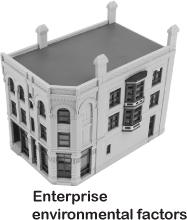
Organizational process assets tell you about how your company normally runs its projects.
Every company has standards for how to run its projects. There are guidelines and instructions for managing projects, procedures you need to follow, categories for various things you need to keep track of, and templates for all of the various documents that you need to create. These things are usually stored in some sort of library.
One of the most important organizational process assets is called lessons learned, which is how you keep track of valuable historical information about your project. At the end of every project, you sit down with the project team and write down everything you learned about the project. This includes both positives and negatives. That way, when you or another project manager in your company plans the next project, you can take advantage of the lessons you learned on this one.
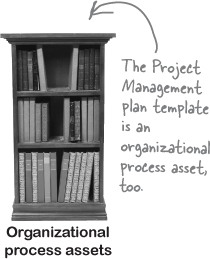
there are no Dumb Questions
Q: I’ve never had a project charter. Is it really necessary?
A: Yes, definitely. Have you ever been on a project where you didn’t feel like you had enough authority to do your job? The project charter gives you the authority to manage your project. Every project should have a charter, and writing the charter is the first thing that should happen on any project.
Q: Wait a minute! How can I be the one writing the charter, when it’s what gives me all of my authority and I might not even be assigned to the project yet?
A: Right, you’re not usually going to write a charter. The charter is usually handed to you. The project manager or the project sponsor can write the charter; only the sponsor approves it. And it’s always easy to tell who the project sponsor is: it’s the person who pays for the project, and comes up with the project’s overall goals.
Q: I’m still not sure I get the idea behind a business case document. How’s that different from the project charter?
A: The business case is a description of what your company is trying to get out of the project—like how much money you’re planning on making from the project, how it will benefit parts of your organization, and future business you might gain from the project.
The project charter is a high-level description of your project. It tells you—and anyone else who needs to know about your project—what you’ll be delivering, including a really high-level description of what it is that you’ll build.
A really important difference between them is that the project charter is what authorizes the project manager to do the work, while the business case helps justify the project. You can think of the business case as the background research that had to be done in order to make sure the project was worth doing, and the project charter as the thing that formally announces the decision to do it.
Q: I’m still not clear on who the sponsor is. How’s that different than the customer?
A: The sponsor is the person (or people) paying for the project. The customer is the person who uses the product of the project. Sometimes the customer is the same person as a sponsor. This is often true in consulting companies. For the teachers’ project, the sponsor is the Acme Travel CEO, and the customers are the teachers. But it’s possible that in another travel agency, the teachers themselves would be the sponsors. This happens a lot in contracted work.
For the exam, you’ll need to be careful about this. Sometimes you’ll see the word customer in a question that’s asking you about the sponsor. You might even see the word client—a word that appears in the PMBOK® Guide only four times! (It’s usually used when you’re talking about procurement.) When you see this, you should assume that the question is asking you about a consulting situation, where the sponsor, customer, and client are all the same person.
Note
The CEO and VP of Asia Travel are paying for this project in the sense that they’re providing funding for the project team at the travel agency and cutting checks to the airlines, hotels, tour groups, and so on. The customers are definitely paying Acme Travel, but they’re not paying out the budget for the specific work that has to be done to complete the project.
Q: Hold on. My project sponsors are really important people in my company. I can’t imagine them actually typing up a project charter.
A: Good point. That’s why the project sponsor will often delegate the actual creation of the charter to the project manager. For the exam, though, keep in mind that the sponsor is ultimately responsible.
The sponsor of a project is responsible for creating the project charter.
The sponsor of a project pays for the project. The PM manages the project.
Note
At Acme, the CEO and VP of Asia Travel were the sponsors. But at another travel agency, Frank and Joanne could just as easily sponsor the project, since they’re the customers.
Plan your project!

Planning the project is when you really take control. You write a plan that says exactly how you’re going to handle everything that goes on in the project. The Develop Project Management Plan process is where you organize all of the information about your project into one place, so everyone knows exactly what needs to happen when they do the project work—no matter what their jobs are.
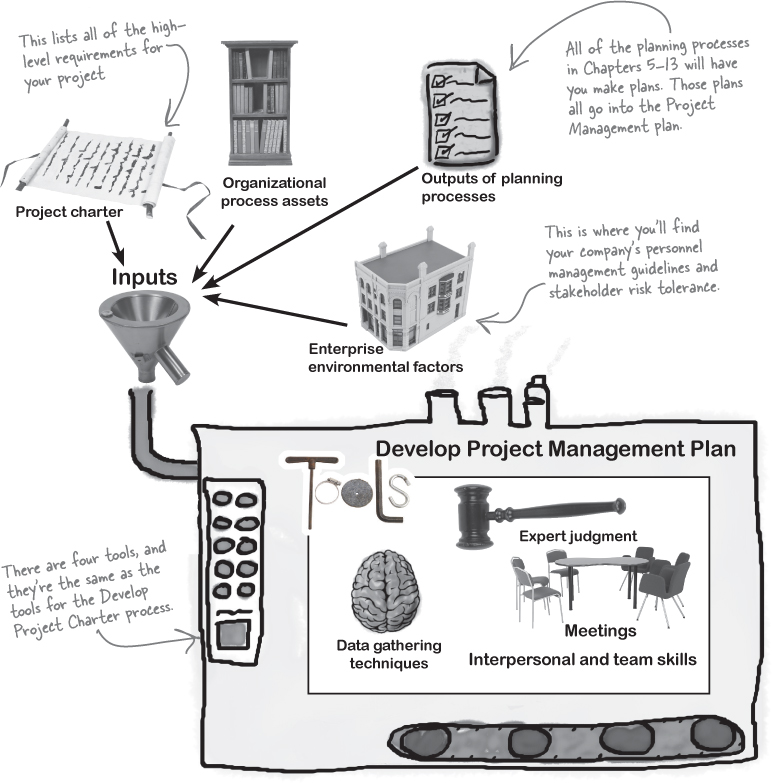
The Project Management plan lets you plan ahead
The Planning process group is where you figure out how you’re going to do the project—because you need to come up with a plan before you bring the team in to do the work. This is where you think about everything that will happen on your project, and try to plot a course to complete it with as few errors as possible.
And it’s where you figure out how you’ll handle changes—because every project has plenty of problems, but not all of those problems mean that you need to change course. If you plan well, your project will make only the right changes.
The Project Management plan is a collection of other plans
The Project Management plan is a single document, but it’s broken into a bunch of pieces called subsidiary plans. There’s one subsidiary plan for each of the other knowledge areas: Scope Management, Schedule Management, Cost Management, Quality Management, Resource Management, Communications Management, Risk Management, Procurement Management, and Stakeholder Management.
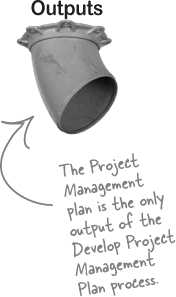
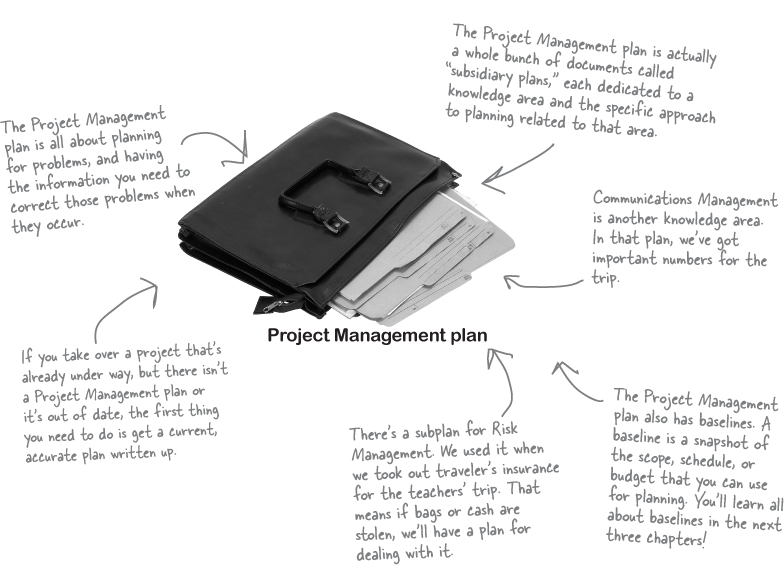

No. The Project Management plan is not the same thing as a project schedule.
You’ll use a tool like Microsoft Project when you’re doing Schedule Management to build the project schedule. (It’s useful for other knowledge areas as well.) But you’ll use your Project Management plan as a guide to help you develop that schedule. It will tell you what tools to use when you develop it, and how changes will be handled.
A quick look at all those subsidiary plans
You’ll be learning about each of the knowledge areas throughout this book, and you’ll learn all about the subsidiary plan that goes with each area. But let’s take a quick look at what each subsidiary plan focuses on.
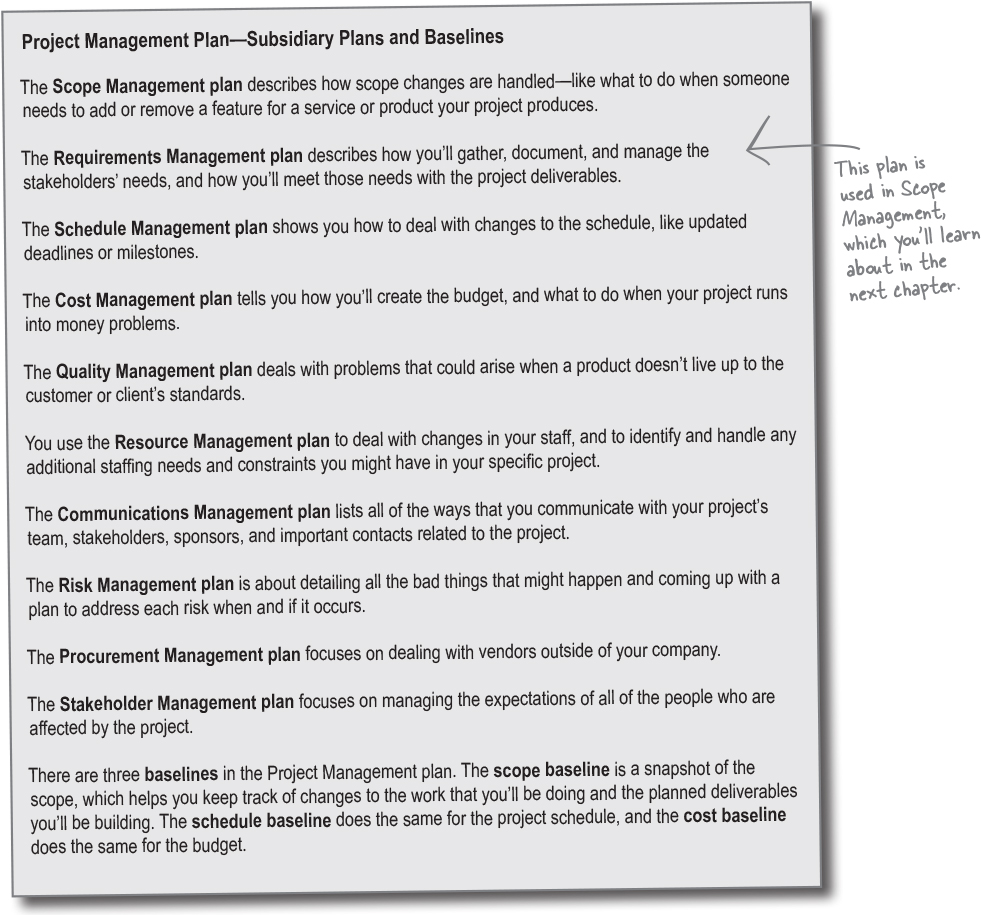
The Project Management plan is the core of Integration Management. It’s your main tool for running a project.
there are no Dumb Questions
Q: How far should I go when trying to anticipate every possible issue and list it in the Project Management plan?
A: It’s really important to think about what could change on your project, so that you can have plans for what to do when things don’t go as expected. An unexpected change can sometimes derail a project, and doing some planning up front can keep issues like that to a minimum. Planning can help you avoid problems in the first place, which is a lot better for everyone than reacting to them when they happen. So think of everything you can; the extra time you spend planning could be what makes your project a success.
Q: Does the project manager create the Project Management plan all by himself?
A: No, it should be a group effort between the PM and the stakeholders. Everyone on the project team and all of the stakeholders need to agree that the plan is acceptable.
Q: What about things that I don’t think about? I’m not sure what they’ll be until the project gets going. Sometimes there are uncertainties, so we base our plans on assumptions...right?
A: You’re never going to think of everything. To help keep your plan flexible, you should add an Open Issues section to the plan. You can write down any open issues or concerns in this section, and deal with them as they come down the line. However, you have to have all your project requirements complete before starting the project—you should never have any requirements in your Open Issues section.
Q: I still don’t get what enterprise environmental factors are.
A: Your company’s enterprise environmental factors are all of the information you have about its policies, processes, departments, and people. You need to know how your company does business in order to manage a project. For example, you need to know about the different departments in your company if you’re managing a project that will be used by people in them. And remember, enterprise environmental factors can also be external factors, like regulations. The important point is that you can’t control them, and need to take them into account.
Question Clinic: The just-the-facts-ma’am question
A great way to prepare for the exam is to learn about the different kinds of questions, and then try writing your own. Each of these Question Clinics will look at a different type of question, and give you practice writing one yourself.
Note
Take a little time out of the chapter for this Question Clinic. It’s here to let your brain have a break and think about something different.
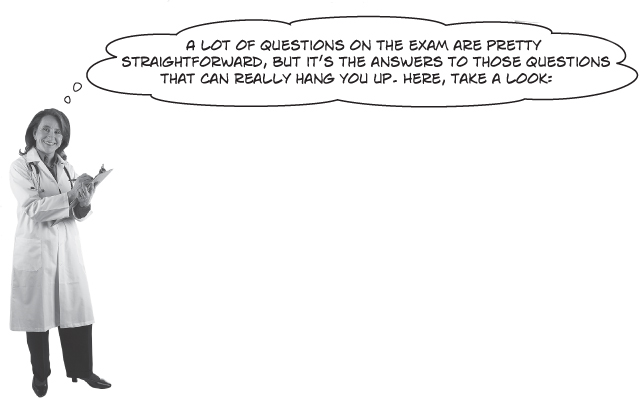
27. Which of the following can be found in the project charter?
Business case document
Note
Some answers will clearly be wrong. The business case document is one of the inputs to the Develop Project Charter process.
Expert judgment
Note
Some answers are a little misleading! This is part of the Develop Project Charter process—but it’s from the tools and techniques, not a part of the project charter itself.
Authorization for the project manager
Note
Here’s the right answer! The project manager’s authorization is included in the project charter.
Project management information system
Note
You haven’t seen this one yet—it’s part of enterprise environmental factors, an input to the Develop Project Charter process, but not in the charter itself.
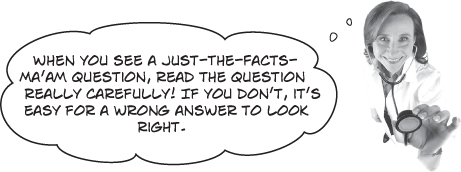

The Direct and Manage Project Work process

Once you have a Project Management plan, your project is ready to begin. And as the project unfolds, it’s your job to direct and manage each activity on the project, every step of the way. That’s what happens in the Direct and Manage Project Work process: you simply follow the plan you’ve put together and handle any problems that come up.
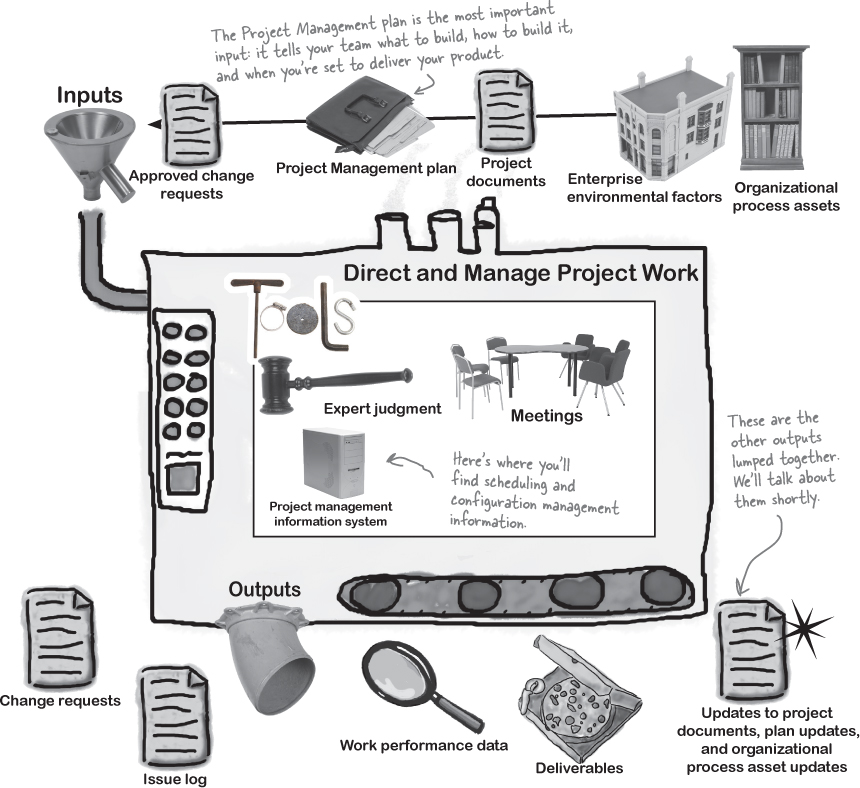
The project team creates deliverables
The work you’re doing on the teachers’ project creates lots of things: airline reservations, hotel reservations, invoices, defect reports, and customer comments (to name a few). These things are all your deliverables, and they are one of the outputs of the Direct and Manage Project Work process.
Another output is work performance data, and that’s what we call the reports Acme’s running on the project. These reports track how many negative versus positive customer comments the project gets, and how well the project is doing at meeting its cost estimates. In fact, a project manager should figure out a way to use the work performance data that is generated from each knowledge area during the Direct and Manage Work process to understand how well the processes are being performed.
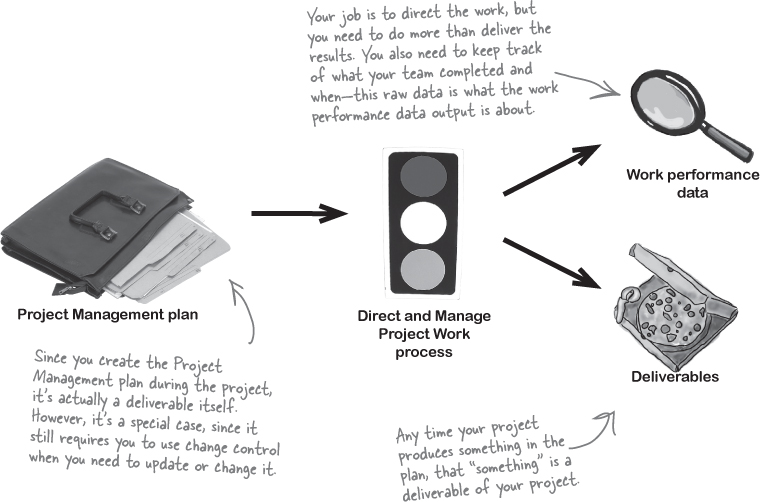
You create work performance data by measuring how and when the processes from each knowledge area are being performed.
Executing the project includes repairing defects
The Direct and Manage Project Work process has a bunch of inputs and outputs—but most of them have to do with implementing changes, repairs, and corrective action. If there’s a defect repair that’s been approved, this is where it happens. Once the defect is repaired, the result is an implemented defect repair. The same is true for changes and corrective actions; once they’re approved, they become process inputs, and then they can be implemented and become process outputs.
Note
Any time you have to correct a mistake or make a repair in a deliverable, you’re fixing a defect.
The three components of the Direct and Manage Project Work process:

Use the plan to create deliverables.
Note
Deliverables are anything you produce in the course of doing your project activities.
Repair defects in deliverables.
Note
Your Quality Management plan focuses on catching defects as you go, so you can repair them as soon as possible.
As the project plan changes, make sure those changes are reflected in the deliverables.
Note
This is different from fixing defects. A defect means that the plan was right, but your deliverable was built wrong.
Deliverables include everything that you and your team produce for the project
The word deliverable is pretty self-explanatory. It means anything that your project delivers. The deliverables for your project include all of the products or services that you and your team are performing for the client, customer, or sponsor.
But deliverables include more than that. They also include every single document, plan, schedule, budget, blueprint, and anything else that gets made along the way…including all of the project management documents that you put together.
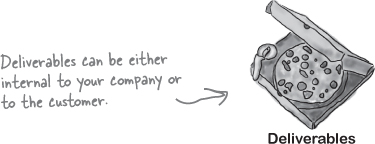
The Direct and Manage Project Work process is where you and your team actually do the work to produce the deliverables.
The Manage Project Knowledge process

The whole time your project is happening, your team is solving problems and learning. The Manage Project Knowledge process is all about using the information your company has already learned from doing past projects and creating new information when your team learns something your company hasn’t encountered before.
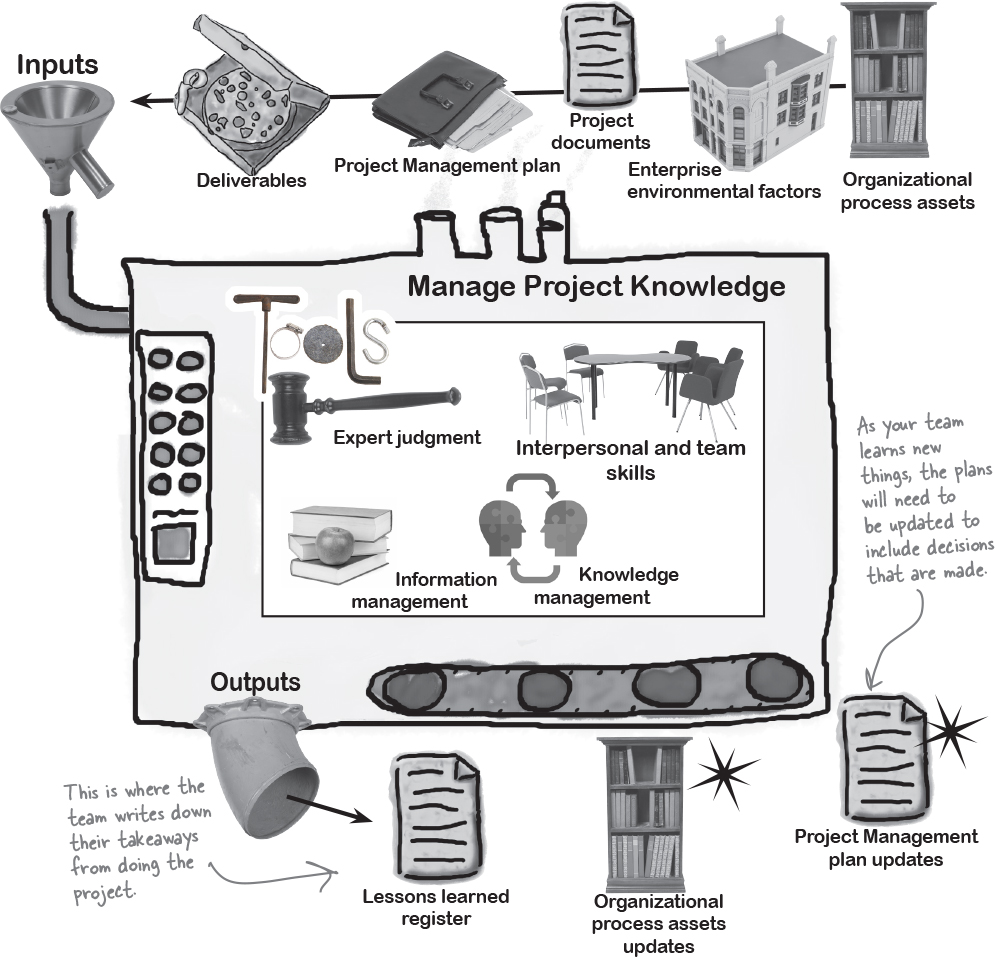
Knowledge is the lifeblood of any project
Who would you rather have running your project: a rookie project manager who’s only been managing projects for a few months, or a seasoned veteran who’s got 20 years of experience? The thing that separates them, more than anything else, is knowledge: the experienced project manager has learned a huge number of lessons throughout her career, and she knows how to apply them to her day-to-day work to make her projects run smoothly. But it’s not just the project manager who has important knowledge; it’s spread across your whole team, your entire organization, and even people outside of it. Some of that knowledge is explicit, or written down in documents, files, data, and so on, but a lot of it is tacit, in people’s heads or embedded in the company’s culture. Getting a handle on this knowledge can be a real challenge for an organization.
That’s where knowledge management comes in. Your team works together every day, and they’re constantly reshaping their understanding of the problems that come up within your project. Knowledge management is about creating opportunities for them to share what they’ve learned with each other and think of new solutions together. Teams will use methods like communities of practice, message boards, distribution lists, workshops, pair programming and work shadowing, and team meetings to help keep everyone on the same page.

It’s not enough for the team to have a shared understanding of the project, though—they need to share that understanding with the rest of the organization. Once the team has identified information from their project that might be useful to the rest of the organization, they need to write it down and share it. Information management is all about creating libraries of information that people both within and outside the project can use if they run into similar situations to the ones your team is encountering. The main document produced by teams to describe what they’ve learned during the project is the lessons learned register.

Note
Teams use lessons learned just like the experienced PM uses her knowledge to make her project run better.
We’ll dive deeper into lessons learned later in this chapter.
Eventually, things WILL go wrong…
Even if you work through all the processes you’ve seen so far, things can still go wrong on your project. In fact, the teachers are already letting you know about some issues they’re having.

…but if you keep an eye out for problems, you can stay on top of them!

Sometimes you need to change your plans
Take a minute and flip back to “Integration Management and the process groups”. Notice how there’s a loop between the Executing and the Monitoring and Controlling processes? That’s because when your team is executing the plan and working on the deliverables, you need to keep a constant lookout for any potential problems. That’s what the Monitor and Control Project Work process is for. When you find a problem, you can’t just make a change…because what if it’s too expensive, or will take too long? You need to look at how it affects the project constraints—time, cost, scope, resources, risks, and quality—and figure out if it’s worth making the change. That’s what you do in the Perform Integrated Change Control process.
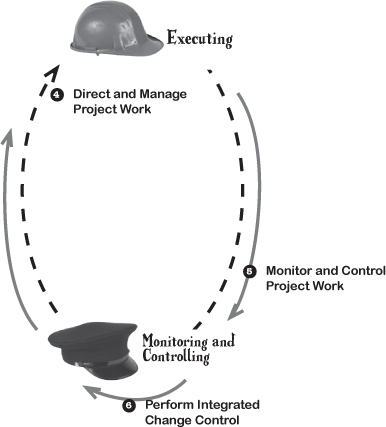
Look for changes and deal with them

You need to stay on top of any possible changes that happen throughout your project, and that’s what the Monitor and Control Project Work process is for. Usually the work is progressing just fine. But sometimes you find out that you need to change something, and that’s when you use the Perform Integrated Change Control process to see if the change is worth the impact it will have on your project.
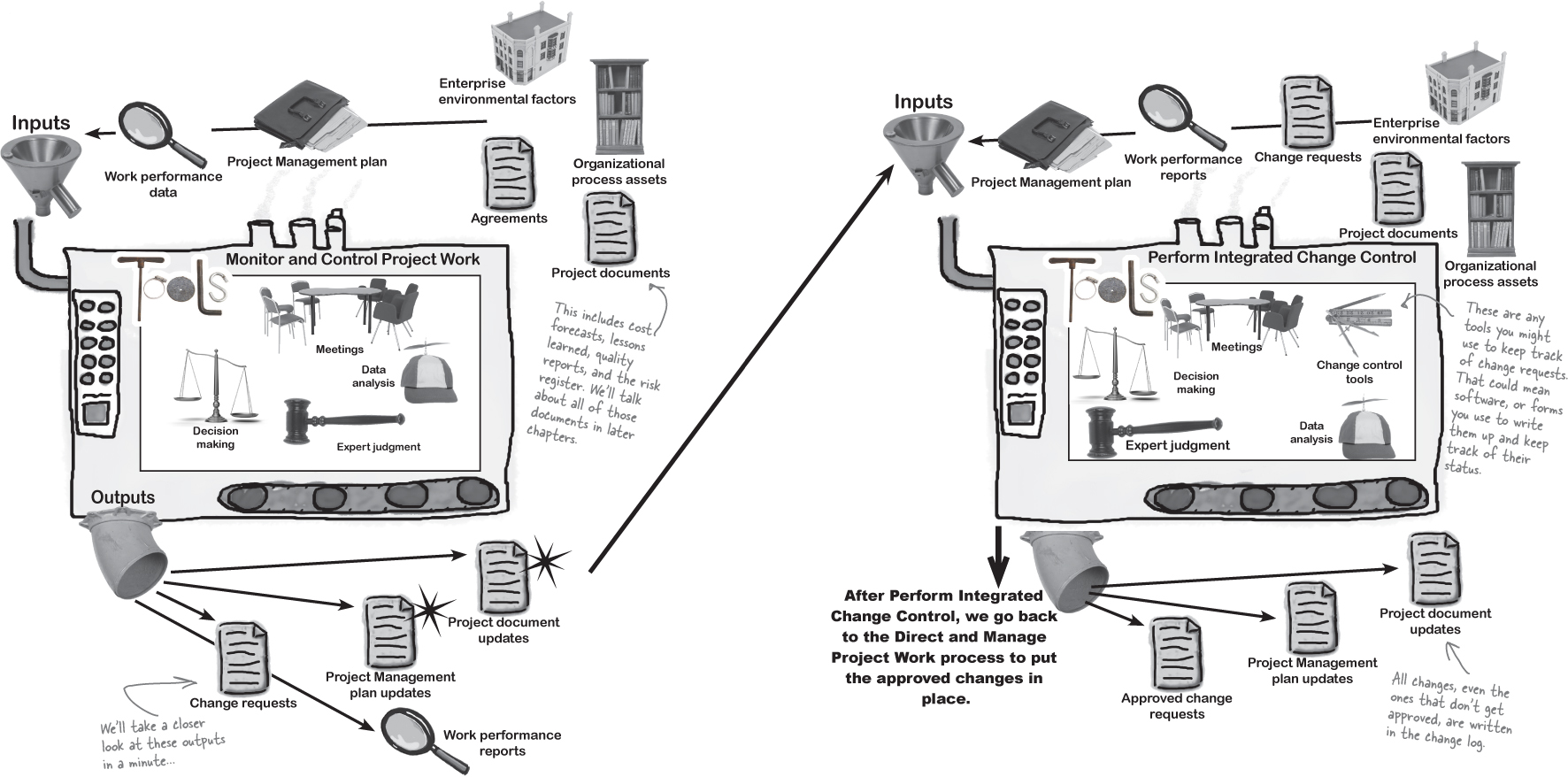
Make only the changes that are right for your project
The Monitor and Control Project Work process is where you find the changes that you may want to make. The Perform Integrated Change Control process is where you decide whether or not to make them. But you’re not the one actually making that decision—a big part of Perform Integrated Change Control is that you need to get your changes approved by the change control board.

How the processes interact with one another
While monitoring the teachers’ trip, you notice that they all ask for nonsmoking rooms every time they check into a hotel. But some hotels don’t have enough nonsmoking rooms available, and the teachers aren’t too thrilled about that.
After you talk it over with the teachers, it’s clear that it’s worth splitting up the group over multiple hotels to make sure they all are in nonsmoking rooms—and some hotels are more expensive than you’d planned. The cost change will put you over budget, so the Cost Management plan needs to be updated. Time to take the request to change control:
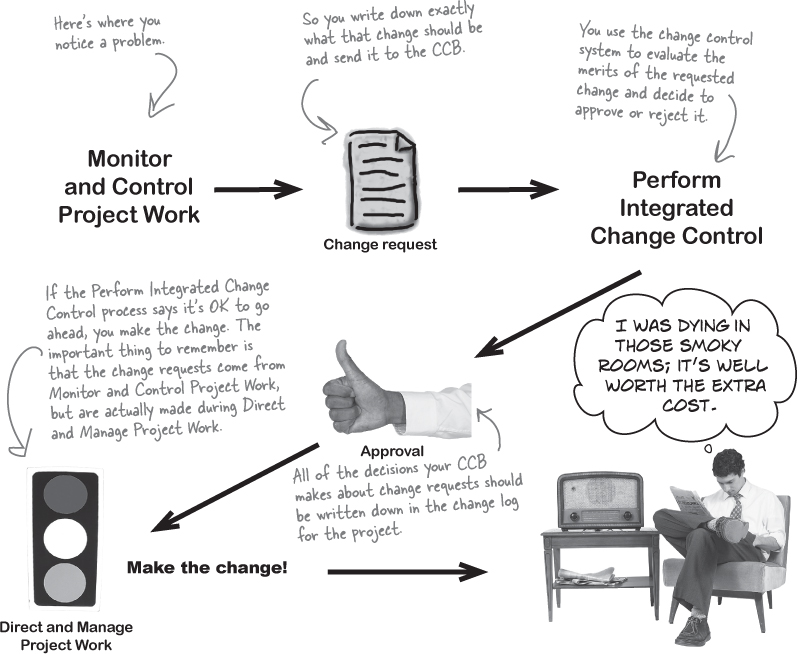
Changes, defects, and corrections
You’ve already seen how a project can change as it goes along. When the teachers asked for their hotel to be upgraded, you took the request through the Perform Integrated Change Control process at Acme, and when the change control board approved the change, you directed the agents to make the booking for the group.
But sometimes, things go wrong with what you intended to have happen in the first place. When your quality department told you that you had booked the teachers on the flight to Rome without putting them in the same row, you quickly fixed the reservation. But you intended for the teachers to sit together in the first place, so that’s not a change, it’s a defect.
In the process, you realized that your team wasn’t reading your documentation carefully, which is why they screwed up the airline reservations. To fix the way your team is working, you need to take corrective action. That’s when you need to change the way you’re doing the work on your project. Got all that?
When the team is repairing defects to deliverables, they still need to go through change control.
Decide your changes in change control meetings
Sometimes a change you make will have a direct impact on other teams and projects, and it’s a good idea to be sure that everybody who will be impacted knows that it’s coming and thinks that it’s worth it before you make the change. You can’t always know everything that might happen as a result of a change, and that’s why it’s a good idea to get buy-in from key people in your company before you go through with it. And that’s what a change control meeting is all about!
Usually, a change control meeting will be a regularly scheduled thing, where people representing the affected areas of the company will get together to review proposed changes and decide whether or not to make them. A change control board is never made up of just the people on your team. A change control meeting is all about getting people with different perspectives together to talk about the pros and cons of changes before deciding whether to approve or reject them.
It’s your job as a project manager to know the impact of requested changes to your project and prioritize them for the change control board. Once you’ve done that, the change control board can make informed decisions about whether or not to approve them.

Control your changes; use change control
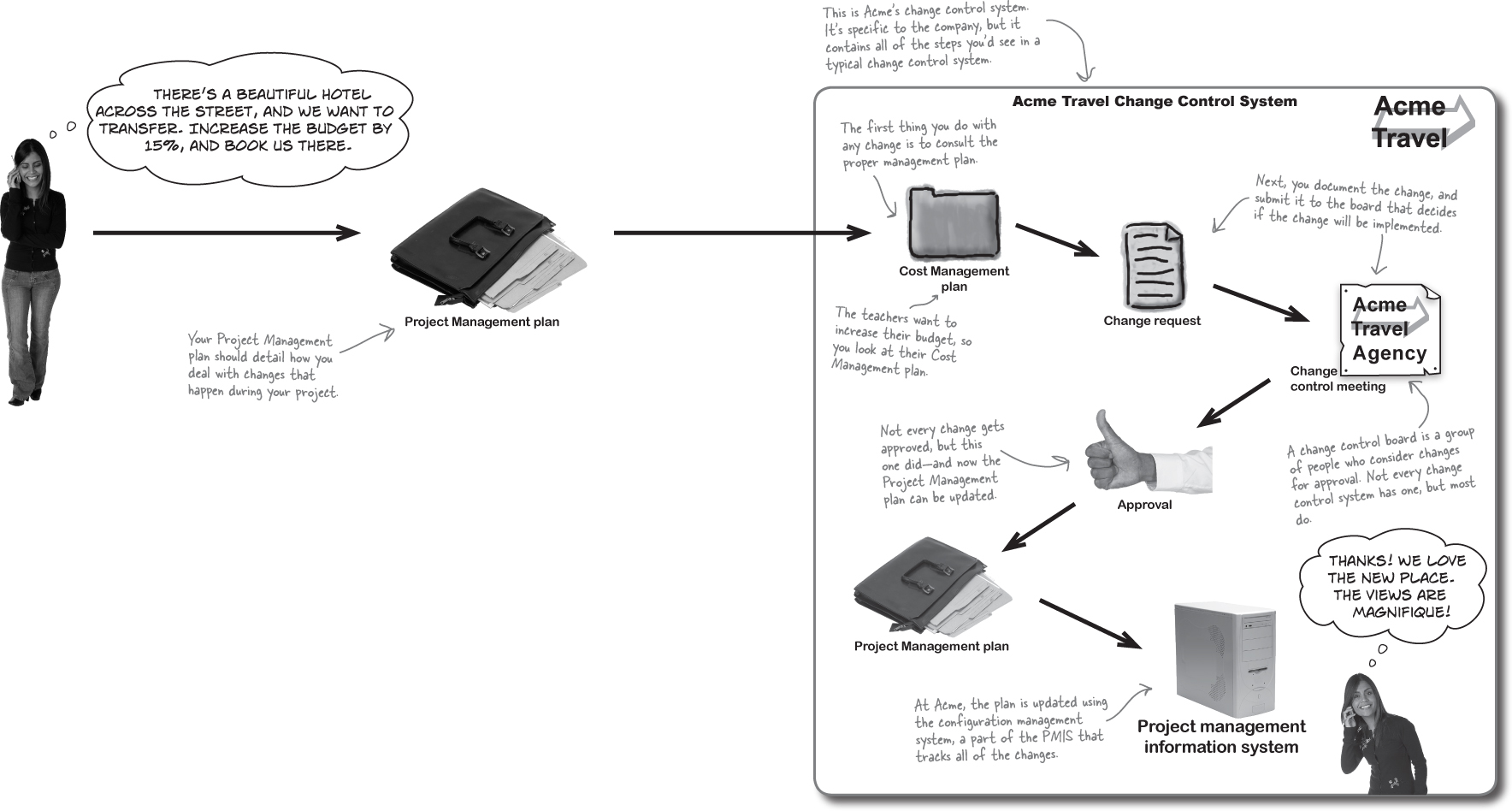
Any time you need to make a change to your plan, you need to start with a change request. This is a document that either you or the person making the change needs to create. Any change to your project needs to be documented so you can figure out what needs to be done. Once you have a change request, that then kicks off your project’s set of change control procedures.
Note
The key here is PROCEDURE—change control is about how your company handles changes. You may use a computer system to monitor and document changes, but that’s just one part of your change control system.
Note
This means you need to write down exactly what needs to be changed and put it in something called a change request. That’s a form that you fill out to send a change through change control.
Change control is how you deal with changes to your Project Management plan.
A change control system is the set of procedures that lets you make those changes in an organized way.
Preventing or correcting problems
When you monitor your project, you might be checking the actual time it’s taking you to do scheduled work versus the amount of time you planned, or you might be gathering information on the number of defects you have found versus the number you expected. In both cases, it’s possible that you might find problems. If you do, you have to change the way you do your work and keep your project from being dragged down. When you make a course change on your project, that’s taking corrective action.
It’s also possible that you might see problems that are going to occur even though they haven’t happened yet. If you do, you will want to take preventive action, or steps that you take to avoid potential problems.
Note
When people predict problems on projects before they happen, it’s called a forecast. A forecast can be a good reason to make a change too!
In both corrective and preventive action, you always need to submit your proposed change and put it through the Perform Integrated Change Control process—and only if it is approved will you implement it. If your recommended action makes it through, you need to change the plan and any of your baselines to include it.
The documented scope, schedule, and cost baselines in the Project Management plan are called the performance measurement baseline.
Note
We’ll learn more about the performance measurement baseline in upcoming chapters.
there are no Dumb Questions
Q: Sometimes my team members come to me and tell me that the project could have problems later. What do I do with that?
A: For some project managers, it seems natural to dismiss these “negative Nellies” who seem concerned with problems that could go wrong in the future. But working with them instead is one of the best ways you can satisfy your stakeholders.
When someone makes an estimate or prediction of a future condition that could lead to trouble, it’s called a forecast, and that’s very valuable information. You should distribute it along with your work performance data, and try to think of ways to avoid the problem—which is what preventive action is all about.
A big part of your job as a project manager is to figure out how to prevent changes. This might seem a little weird—how can you prevent changes before the project is implemented? One way to do this is to plan as well as possible, because a lot of changes happen because of a lack of planning. But it also means talking to stakeholders throughout the project and keeping an eye out for potential problems. When you take the PMP exam, if you see the phrase “influencing factors that cause change,” this is what it’s referring to.
Q: Who approves changes?
A: Usually there’s a change control board (CCB) that approves changes. That’s a group of people, most often including the stakeholders and sponsor, who look at the benefits of a change and figure out if it’s worth the cost. If there’s a CCB, your change control system will include a procedure that mentions it. But not every company has a CCB, and there is no requirement in the PMBOK® Guide that you have one.
Q: What if there’s a problem outside my project, and I’m not sure it affects me?
A: You should still consider its potential impact when you’re monitoring your project’s work. It’s important that you’re always on the lookout for potential problems. If you’re not sure whether something could impact your project, it’s your responsibility as a project manager to bring it to the attention of your stakeholders. And if you can make a change on your own that doesn’t impact the project constraints (scope, cost, time, quality, risk, or resources), then it’s completely within your rights as a project manager to do it.
Q: Once a change is approved, what do I do with it?
A: You change your Project Management plan to incorporate the change. This can mean that you create a new baseline with the new Project Management plan. For example, say you forgot to add a stakeholder to the change control board, so your project plan now describes the wrong process for making changes. You’ll need to fix that, and you’ll need to go through change control to do it.
Every time a change is reviewed by the change control board, you keep a record of it in your change log. So whether the change was approved or rejected, the change request and the decision the CCB makes about it should be documented.
Q: What about changes that don’t affect the project constraints?
A: If you evaluate the impact of a change and find that it won’t have an impact on the project constraints, then you can make the change without going through change control. Sometimes you need to change resources or move tasks around, and you can make those changes without affecting the bottom line or the end product. In these cases, change control wastes time and resources, rather than helping your project.
Q: Now, what’s a performance baseline again, and what do I do with it?
A: A performance baseline is a snapshot of your project’s scope, schedule, and cost. When you plan out the work you’ll do on a project, you write down all of the activities you’ll need to do and save that understanding as your scope baseline. You’ll do the same with your understanding of the project’s schedule and its cost. That way, you can always compare your actual performance to your plan.
Every time a change is approved, that means the plan has changed. So you have to update your baseline to include the new work (or cost, or schedule).
You always have the authority to make changes to your project if they don’t affect cost, schedule, or scope.
Finish the work, close the project
You can’t finish the project until you get paid! Most projects start with contracts, and when they do you need to make sure the terms are met. Acme signed a contract with the Midwestern Teachers’ Association when the project started, and now it’s time to make sure all of the parts of that contract are met. And that’s part of what you do in the Close Project or Phase process. But an even more important part of this process is that you create updates to your company’s organizational process assets. That way you and other project managers can learn from this historical information in the future. The inputs to the Close Project or Phase process include the project management plan, organizational process assets, and accepted deliverables. And you use the same familiar tools and techniques that you’ve seen throughout the chapter.
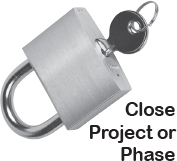
The most important output of the Close Project or Phase process is the final product that you deliver to the customer!
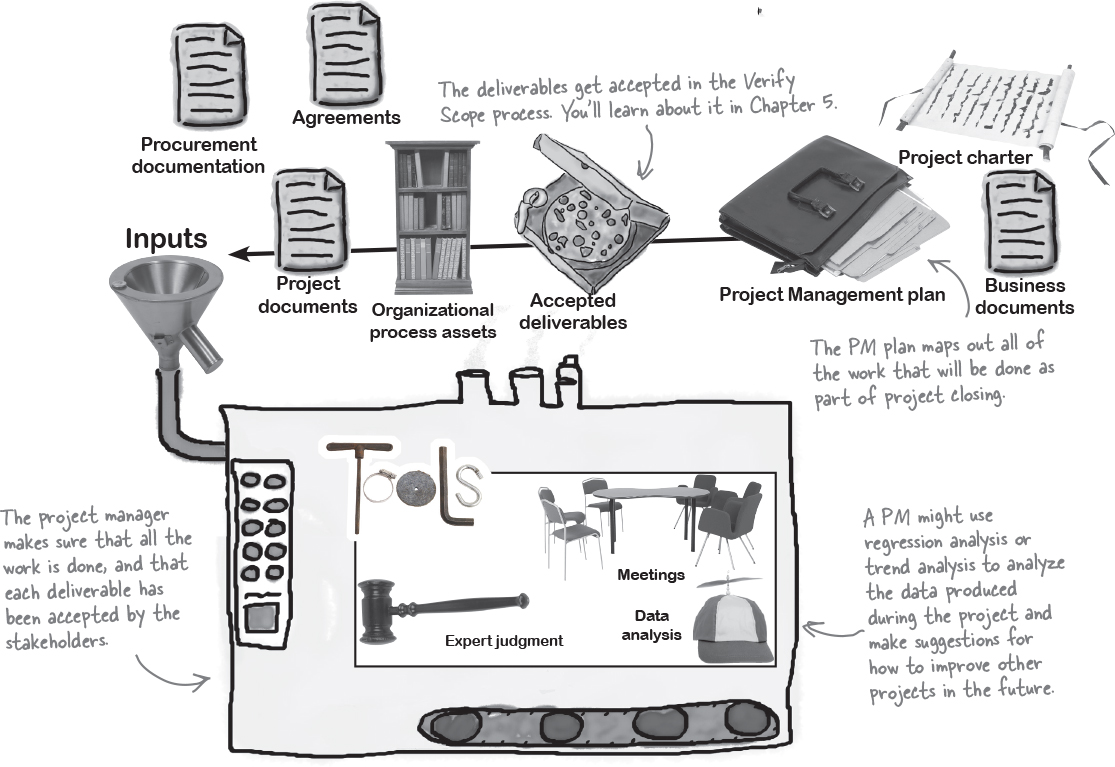
You don’t have to go home, but you can’t stay here

The teachers have gone through their entire itinerary. They’re now on their way to Paris, which is the final leg of their tour. They’ve had a great time, and now it’s time for you to finish up.
Every project needs to end, and that’s what the Close Project or Phase process is all about. You want other travel agents at Acme to learn from anything new you’ve discovered. Remember how you had to scramble with the nonsmoking room request? Maybe your friends at Acme can learn from that, and ask new clients up front what they want! That’s why you write down your lessons learned, and that’s a big part of closing the project.
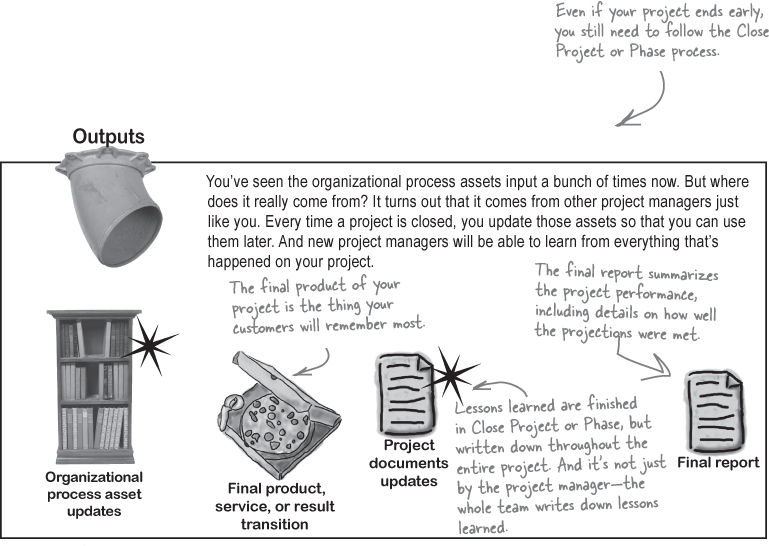
So why INTEGRATION Management?
The Integration Management knowledge area has all of the processes that you do in your day-to-day work as a project manager. So why are they called “Integration Management” processes? Well, think about what it takes to run a project: you need people and other resources from all around your company; knowledge about how your company does its business; standards, templates, and other assets that you’ve gathered from other projects; and the ability to put it all together—that’s what a project manager does. And that’s where the “integration” part comes in.
This is especially important when you need to work with consultants, because your job is to procure services for the project. And you need to plan for all of it at the beginning—which is when you integrate all of these things together into a single plan. It’s your job to make sure that every one of the 49 processes in the PMBOK® Guide is addressed in the plan, even if you’re not going to use it (for example, if you don’t need contractors or consultants, you won’t use Procurement processes).
Integration Management means making sure that all of the processes work together seamlessly to make your project successful.
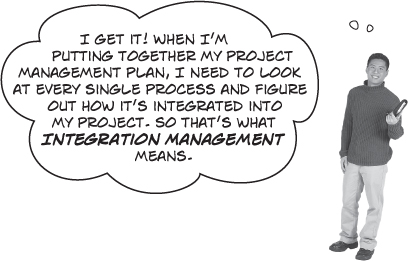
What else is there?
Huh…it seems like we covered the whole project, right? You got authorized to do the work, you planned the project, you executed it, you corrected problems along the way, and you closed it out. Isn’t that everything?
Well, of course not! There’s a whole lot more planning that you have to do, and many skills that you need to have. Luckily, we’ve got the PMBOK® Guide to help us figure out exactly what we need to know to manage projects effectively.
Note
That’s what the rest of the book is about.
Project Integration Management Magnets

These inputs, outputs, and processes are all scrambled up on the fridge. Can you reconstruct them so that the processes go under the correct process groups, and the inputs, outputs, and tools go in the right categories?
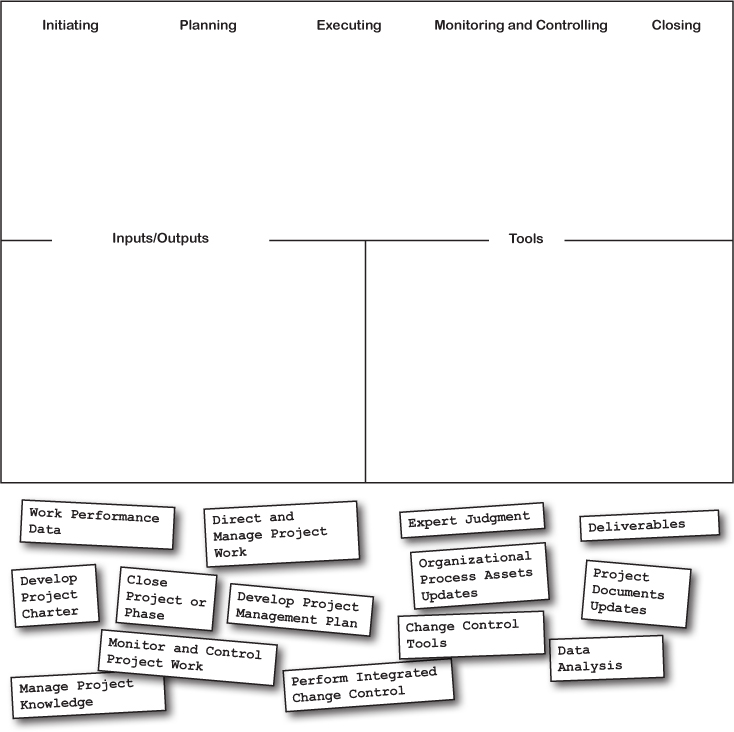
Project Integration Management Magnets Solution
These inputs, outputs, and processes are all scrambled up on the fridge.
Can you reconstruct them so that the processes go under the correct process groups, and the inputs, outputs, and tools go in the right categories?

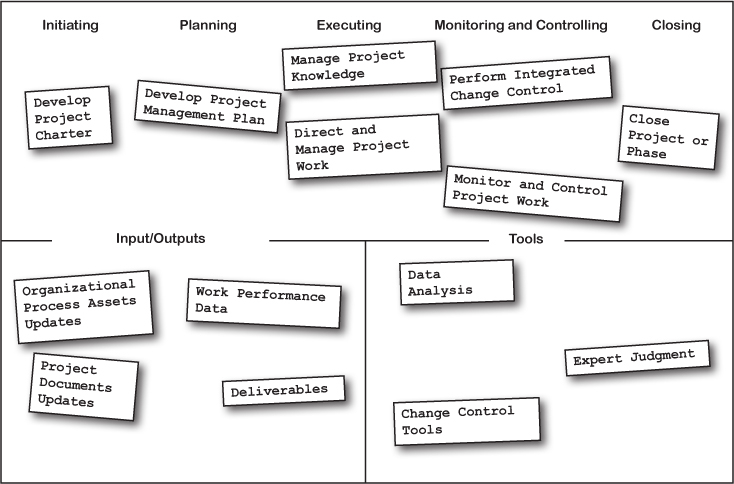
Integration Management kept your project on track, and the teachers satisfied
By using all of the Integration Management processes, you kept the project on track. You handled all of the problems that came up, making some important changes in the process, and the teachers got to all of their destinations on time and on budget.
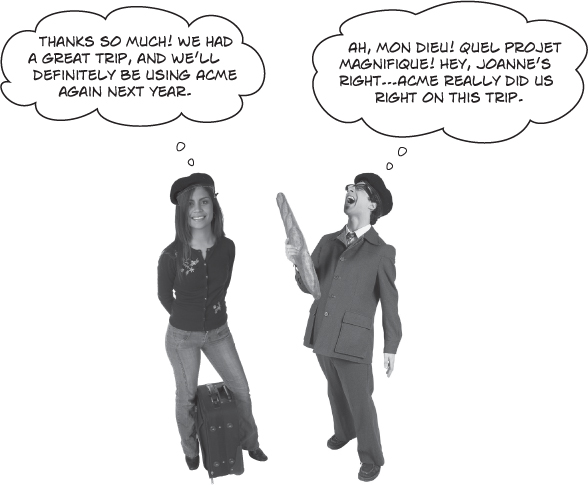
Exam Questions
You’ve just received a change request. This means:
The project charter is complete, but the work cannot begin yet because you need to make a change to the scope baseline.
You are in the Direct and Manage Project Work process, and you can implement the change now.
The change needs to be approved before it can be implemented.
There is a defect in a deliverable that must be repaired.
Which of these is not an input to Develop Project Charter?
Enterprise environmental factors
Project management plan
Agreements
Business documents
What is the output of Direct and Manage Project Work?
Approved change requests
Project Management processes
Deliverables
Forecasts
You’re managing a graphic design project. One of your team members reports that there is a serious problem, and you realize that it will cause a delay that could harm the business of the stakeholders. Even worse, it will take another two days for you to fully assess the impact—until then, you won’t have the whole story. What is the BEST way to handle this situation?
Create a change request document and submit it to the change control meeting.
Pull out the project charter and show them that you have authority to make decisions.
Meet with the stakeholders and tell them that there’s a problem, and you need two more days to get them the information they need.
Update the lessons learned and add it to your organizational process assets.
You’re a project manager on a construction project. The electrician has started laying out the wiring, when the client comes to you with a change request. He needs additional outlets, and you think that will increase the cost of the electrical work. What is the first thing you do?
Refuse to make the change because it will increase the cost of the project and blow your budget.
Refer to the Project Management plan to see how the change should be handled.
Consult the contract to see if there is a clause.
Make the change, since the client requested it.
The work authorization system:
Ensures that every work package is performed at the right time and in the proper sequence
Authorizes the project manager to spend money on work
Is a set of processes and tools that aids the project manager in effectively guiding the project to completion
Is a formalized, written description of how to carry out an activity
You’re the project manager at a telecommunications company. You recently had stakeholders approach you with changes. You figured out that the changes would cost additional time and money. The stakeholders agreed, you were given additional time and budget, and the changes were approved. Now you have to incorporate the changes into the project. What do you do next?
Modify the project charter to include the changes.
Use the project management information system to make sure the work is performed.
Make sure to track your changes against the project’s baseline so you know how much they eventually cost.
Incorporate the changes into the baseline so you can track the project properly.
You are a project manager on a software project. When you planned the project, your enterprise environmental factors included a policy that all changes that cost over 2% of the budget need to be approved by the CFO, but smaller changes could be paid for by a management contingency fund. One of your stakeholders submitted a change request that requires a 3% increase in the budget. Your company has an outsourcing effort, and you believe that a small change to the way that the change is requested could allow you to take advantage of it and cut your costs in half. What is the BEST way to handle this situation?
Work with the stakeholder to figure out how to reduce the cost of the change by a third.
Request approval from the CFO.
Refuse the change because it is over 2% of the budget.
Document the change request, since all changes must be documented.
You’re on the project selection committee. You’re reviewing a document that describes the strategic value of a potential project and its benefits to the company. What’s this document called?
Project charter
Business case
Benefit measurement method
Contract
One of your team members has discovered a defect in a deliverable and has recommended that it be repaired. Which of the following is NOT true:
The project charter has authorized you to perform the work.
Your project is in Monitor and Control Project Work process.
The defect repair must be approved before the deliverable can be repaired.
You must update the Project Management plan to document the defect.
You are holding a formal, approved document that defines how the project is executed, monitored, and controlled. You are holding:
The Project Management plan
The performance measurement baseline
The project charter
The work breakdown structure
You are the project manager for a software project, when the sponsor pulls the plug and cancels the project. What do you do?
Give the team the day off to recuperate from the bad news.
Create a budget summary for the remaining unspent budget.
Follow project closure procedures to close the project and update lessons learned.
Find new assignments for any people previously assigned to your project.
You are managing a software project, when you find out that a programming team whom you were supposed to have access to has been reassigned to another project. What is the first thing that you should do?
Figure out the impact that this will have on your project.
Bring a copy of your project’s charter to the other manager, and explain that you need that team for your own project.
Go to your sponsor and demand the team.
Figure out a way to compress the project schedule so that you can work with the team if they become available.
You are a project manager on a software project. There are several changes that need to be made, and you need to decide how to apply project resources in order to implement them. What do you do?
Decide the priority of the changes and announce them to the team.
Call a team meeting and invite the stakeholders, so that everyone can reach a consensus on the priority.
Deny the changes because they will delay the project.
Consult the Change Prioritization plan for guidance on prioritizing new changes.
You’re a project manager on a software project. Your team is busy executing the project and creating the deliverables, but there have been several changes requested by stakeholders over the past few weeks. Each time you got one of these changes, you called a meeting with your team and the stakeholders to discuss it. Why did you do this?
Every change needs to be evaluated by a change control board.
You’re delegating the work of evaluating changes.
You do not have a good change control system in place.
You are using a project management information system to assign the work.
You are the project manager on a construction project, and you have just received a change request. You consulted the Project Management plan, and followed the procedures laid out in the change control system. You are in the process of reviewing the change and documenting its impact. Your manager asks you why you are doing this. Which process are you doing by reviewing the change and documenting its impact?
Perform Integrated Change Control
Monitor and Control Project Work
Manage Requested Changes
Direct and Manage Project Work
Which of the following is NOT true about the project charter?
The project charter defines the requirements that satisfy customer needs.
The project charter defines the work authorization system.
The project charter makes the business case that justifies the project.
The project charter includes the milestone schedule.
You have just verified that all of the work on your project is completed. Which of these things is NOT part of the Closing process?
Update historical information by documenting lessons learned.
Document the work performance data to show the deliverables that have been completed and record the lessons learned.
Verify that all of the deliverables have been accepted by the stakeholders.
Follow the project closure procedure.
Which of the following is NOT true about the Project Management Plan?
The Project Management plan contains the Scope Management plan.
The Project Management plan gives authority to the project manager.
The Project Management plan contains the schedule baseline.
The Project Management plan contains the performance baseline.
Which of the following is NOT an output of the Direct and Manage Project Work process?
Work performance data
Deliverables
Project documents updates
Forecasts
You are a project manager starting a new project. Your manager warns you that previous projects ran into trouble. Which of the following would be BEST for you to rely on to help plan your project:
Our project management expertise
Historical information
The change control system
Forecasts
Which is NOT true about the project charter:
The project manager must be consulted before the charter is finalized.
The charter is issued by the project sponsor.
The project manager’s authority to manage the project is granted by the charter.
The charter gives a summary milestone schedule.
Which of the following is NOT an input to the Develop Project Management Plan process?
Outputs of the planning processes
Project charter
Expert judgment
Enterprise environmental factors
You are the project manager on a network engineering project. Two weeks ago, your team began executing the project. The work has been going well, and you are now a day ahead of schedule. Two stakeholders just approached you to tell you that they have an important change that needs to be made. That change will put you behind schedule. What do you do?
Implement the change because you’re ahead of schedule.
Refuse to make the change because the stakeholders did not take it to the change control board.
Refuse to make the change until the stakeholders document it in a change request.
Make sure the stakeholders know that you’re open to change, and tell them to talk to the project sponsor.
Diane is a project manager at a software company. She just got a change request from one of her stakeholders, but is concerned that it will cause a serious problem with her schedule. She called a meeting with the project team, and decided that there was a real change, and now they need to start change control. Which of the following is NOT an output of the Perform Integrated Change Control process?
Project document updates
Approved Change Requests
Project Management plan updates
Change requests
Note
Start thinking about the kinds of questions you’re seeing. Some have extraneous details—we call them “red herrings.” Others are about inputs and outputs. That will definitely make the exam more familiar and easier.
Watch out for those red herrings.
Take some time to go over the answers to these questions and if they did throw you off track, reread the question to understand why.
Just remember…if you get something wrong now, that means you’re actually MORE likely to remember it on the exam! That’s why practice exams are so useful.

Exam Answers
-
This is really a question about inputs and outputs. There’s only one process that takes “change requests” as an input, and that’s Perform Integrated Change Control. That’s where your changes get approved. The other answers all refer to other processes: A is about building a baseline (which is part of Develop Project Management Plan), while B and D are both about Direct and Manage Project Work.
Answer: B
The Project Management plan is created in the Develop Project Management Plan process, which happens after Develop Project Charter. Develop Project Charter is the very first process on any project, and the inputs in answers A, C, and D exist before the project started. The Project Management plan is created during the project.
Note
This is a “which-is-not” question. When you see a question asking you to choose which input or output is not associated with a process, one good strategy is to try to think of what it is that process does.
Answer: C
The whole reason for the Direct and Manage Project Work process is to actually do the project work, and the deliverables are the products or services that are created by the project. Don’t get fooled by answer D—even though the work is performed in Direct and Manage Project Work, the information about how that work is performed is turned into forecasts in Monitor and Control Project Work.
Note
That makes sense. You need to monitor the work to figure out how well it’s being performed.
Answer: C
When you get a question about communication, look for the answer that provides the most complete, honest, and up-front information, even if that information won’t necessarily solve the problem or make everyone happy.
Answer: B
All changes must be handled using the change control system, which is a set of procedures that is contained in the Project Management plan. There is no way to tell from the question what specific steps will be in that change control system—answers A, C, and D are all possible ways to deal with changes, depending on the situation. The only way to know for sure what to do is to follow the change control procedures in the Project Management plan.
-
This is a just-the-facts-ma’am question, and answer A is the actual definition of the work authorization system. (This term is used in the PMBOK® Guide—technically it’s not specifically defined there, but you might still see it on the exam.)
Answer: D
The first thing you do after a change is approved is to update the baseline. If you chose answer C, don’t feel bad—it’s easy to get a little mixed up about what a baseline is used for. The whole purpose of the baseline is to figure out whether your project has deviated from the plan. But a change isn’t a deviation from the plan! A deviation is accidental, while a change is done on purpose. That’s why it’s so important to get the change approved: that way, everyone knows about it, which means that you can plan for it. And updating the baseline is how you do that planning.
Note
You use the baseline to protect yourself from nasty surprises…and an approved change is not a surprise.
Answer: B
When your company has a policy, you need to follow it and not try to work around it. Also, don’t get fooled by answer D—the question said that a change request was submitted, so it’s already documented. The exam could contain tricks like that!
Note
The important stuff in this question is all in the second and third sentences. The outsourcing detail is a red herring.
Answer: B
This is a business case—it describes the benefits of doing a project and can be used to decide whether it’s worth it for your company to do the work. Sometimes the benefits will be about gaining capabilities, not just money.
Note
There will be questions on the exam where there are two valid answers but only one BEST answer.
Answer: D
Defects do not need to be documented in the Project Management plan. Take a look at the other answers—do you understand why they are correct? Answer A is simply the definition of the project charter; it doesn’t have anything to do with the defect, but it’s still true. When you’re performing the Monitor and Control Project Work process, you need to make sure defect repairs are approved before you change the deliverables, so answer B is true as well. And as far as answer C goes, that’s the whole purpose of the Perform Integrated Change Control process: to approve defect repairs, changes, and preventive and corrective actions!
-
This is the definition of the Project Management plan!
Answer: C
Even when a project is terminated, you still need to close it out.
Answer: A
If a resource is not available to you, it doesn’t matter what’s in your project charter or what your sponsors and stakeholders want. You need to figure out how to move forward from here, and the first step in doing that is evaluating the impact that this new problem will have on your project.
Note
A question like this needs you to actually think about what you’d do—it’s not just about applying a rule that you’ve learned.
Answer: A
The project manager must decide the priority of the changes. If the changes need to be made, that means that they were approved. So you can’t simply deny them. And you can’t call the team in for a meeting, because they need to do the work. Some people may think that the stakeholders need to be involved—but since the change was already approved, you’ve gotten their buy-in. Now it’s up to you to decide the order in which they’re implemented.
Note
There’s no such thing as a Change Prioritization plan! Keep an eye out for fake artifacts and processes.
Answer: C
When you get a change request, you need to consult the Project Management plan and follow the procedures defined in the change control system. It is generally not a good idea to involve the entire team in evaluating each change that comes in—there may be many changes, and if you pull your team off the job for each one, they’ll never get their job done!
Note
This is NOT a good change control board because a change control meeting doesn’t usually include the whole team!
Answer: A
Once a change is requested, all of the work that you do with it falls under Perform Integrated Change Control, right up until it’s approved and you can implement it.
Note
Doesn’t C seem like the right answer? Too bad it’s not a real process!
Answer: B
The work authorization system is defined by the company, and it’s external to the project. You can think about it as the rules that you are told to follow in order to assign work in your company. They are part of the enterprise environmental factors, an input to Develop Project Charter.
Note
Remember that lessons learned are documented throughout the project, not just at the end! That’s why they’re part of work performance data.
Note
When you close a process or phase, you need to make sure each deliverable has been accepted by the stakeholders.
Answer: B
The work performance data is documented as part of Direct and Manage Project Work. By the time the project closes, it’s too late to use the work performance data! That’s why it’s an input to Monitor and Control Project Work—so you can take corrective action if the work is not being performed well.
Answer: B
The project charter authorizes the project manager.
Note
We’ll learn about Scope Management in the next chapter.
Answer: D
You’ll learn about forecasts in Chapter 7—they’re used to help predict whether the project will come in on time and within budget. If not, preventive or corrective actions will be needed! But you don’t need to know that to know they’re not an output of Direct and Manage Project Work.
Answer: B
Historical information is an important input into Develop Project Charter, which is the first process that you perform when you start a new project. Historical information is very important, because it’s how you learn about past projects’ successes and failures. It’s not actually listed as its own input. It’s a part of organizational process assets—and it really is a huge asset to any organization!
Note
When you add lessons learned to your organizational process assets, you’re recording important historical information that other project managers can use later.

-
The project manager may be consulted when the project charter is created, but that’s not always the case. It’s possible that the project manager for a project is not even known when the charter is created!
Answer: C
While you may employ good judgment in developing your Project Management plan, expert judgment is not an input. It’s a tool/technique used in the various processes.
Answer: C
The first step in handling any change is to document it. That’s why change requests are an input to Perform Integrated Change Control: the change control process cannot begin until the change is written down!
Note
Didn’t D look like a good answer?
Answer: D
If you’re having trouble remembering what the inputs and outputs are for Monitor and Control Project Work and Perform Integrated Change Control, one way to think about it is that change control is all about deciding whether or not to do something. Monitor and Control Project Work is where you spot the problems—that’s why all of the requested changes are outputs of it, and inputs into Perform Integrated Change Control.
Perform Integrated Change Control is where those recommendations get evaluated and turned into approved actions and changes. The ones that are not approved are rejected. Then they go back to Direct and Manage Project Work, where they are implemented, because that’s project work and all project work happens in that process.

Note
Remember, this is how you handle changes: Find it…evaluate it…fix it.
So how did you do?
Get Head First PMP, 4th Edition now with the O’Reilly learning platform.
O’Reilly members experience books, live events, courses curated by job role, and more from O’Reilly and nearly 200 top publishers.

